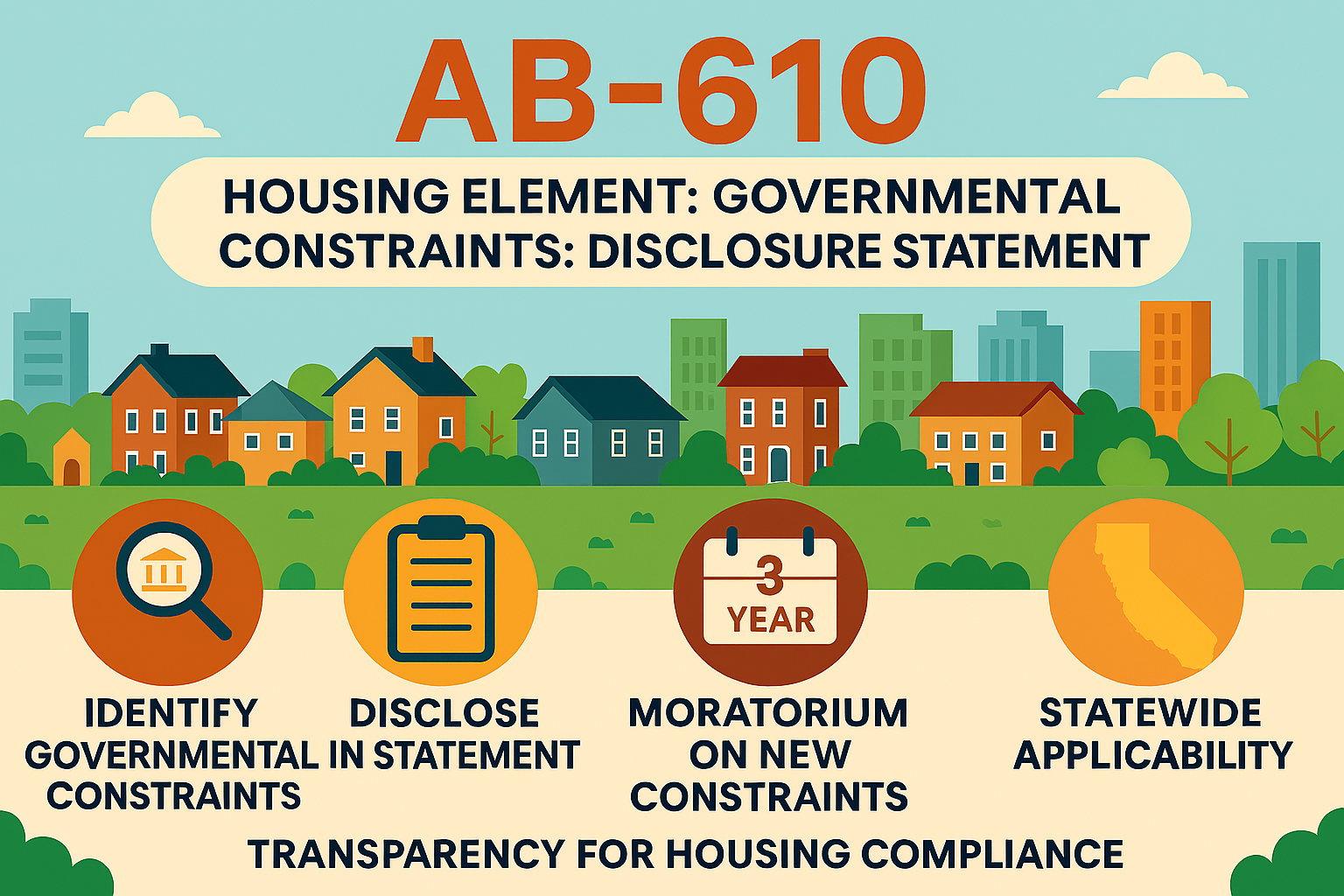I. Legislative Context
California’s Planning and Zoning Law mandates every city and county to adopt a general plan that includes a comprehensive housing strategy to meet the jurisdiction’s share of regional housing needs. Historically, housing elements have included an analysis of governmental constraints (e.g., zoning ordinances, fees, permit processes) that affect housing development. However, a significant issue has been the introduction of new constraints by local jurisdictions after their housing elements were certified by the Department of Housing and Community Development (HCD), which has undermined housing production goals.
AB-610, authored by Assemblymember David Alvarez, addresses this loophole by requiring a Governmental Constraints Disclosure Statement and imposing restrictions on post-certification regulatory changes.
II. Statutory Amendments
AB-610 amends Government Code §65583 and adds §65583.5, introducing the following requirements:
A. Disclosure Statement
For the 7th and subsequent housing element cycles, jurisdictions must include a Governmental Constraints Disclosure Statement that:
1. Identifies each new or amended governmental constraint adopted after the previous housing element’s due date and before submission of the current draft.
2. Lists any proposed or anticipated constraints under consideration during the current planning period.
B. Definition of “Covered Governmental Constraint”
The bill defines covered constraints as:
- Fees, exactions, or affordability requirements.
- Policies reducing land use intensity for residential development.
- Measures increasing procedural burdens or restricting benefits under the Density Bonus Law.
- New or stricter historic designations affecting sites in the housing element’s inventory or rezoning programs.
III. Moratorium on New Constraints
AB-610 prohibits jurisdictions from adopting new or more stringent covered constraints for three years after HCD certifies substantial compliance, unless:
- The constraint was disclosed in the statement, and
- The jurisdiction has completed all commitments to eliminate or mitigate constraints from prior and current planning periods.
Exceptions apply only for emergency health/safety issues or state/federal mandates.
IV. Enforcement and Statewide Applicability
- AB-610 declares housing planning a matter of statewide concern, significantly impacting its provisions to charter cities.
- It preserves HCD’s authority to review and decertify housing elements if jurisdictions fail to comply with the requirements.
- Violations could trigger loss of housing element compliance, exposing jurisdictions to builder’s remedy lawsuits under the Housing Accountability Act.
V. Technical and Administrative Challenges
A. Forecasting Future Constraints
Local governments must anticipate potential regulatory changes over an eight-year planning horizon, a requirement critics call “unworkable” and legally ambiguous.
B. Interaction with Other Statutes
AB-610 incorporates changes contingent upon the enactment of SB-340 and AB-650, creating complex interdependencies in Government Code § 65583.
C. Compliance Costs
The bill imposes state-mandated local programs without dedicated funding, forcing jurisdictions to absorb costs or pass them to developers through higher fees.
VI. Policy Implications
- Transparency and Predictability: AB-610 provides developers with clearer insight into regulatory risks, potentially improving financing and project timelines.
- Local Autonomy vs. State Oversight: AB-610 intensifies governance tensions, as cities argue the bill constrains their ability to respond to evolving community needs.
- Legal Risk: Charter cities may challenge AB-610’s preemption under the California Constitution, though courts have historically upheld housing laws as matters of statewide concern.
VII. Recommendations for Implementation
· Develop HCD Guidance: Standardized templates for disclosure statements.
· Clarify Definitions: Avoid misclassification of pro-housing policies (e.g., inclusionary zoning) as constraints.
· Provide Technical Assistance: Fund training for planning staff.
· Phase-In Compliance: Allow smaller jurisdictions extended timelines.
Conclusion
AB-610 represents a significant evolution in California’s housing governance framework. By mandating disclosure and restricting post-certification constraints, the bill seeks to ensure housing elements are enforceable commitments rather than aspirational documents. However, its success is contingent upon clear implementation protocols, adequate funding, and collaborative governance that balances state mandates with local flexibility.
